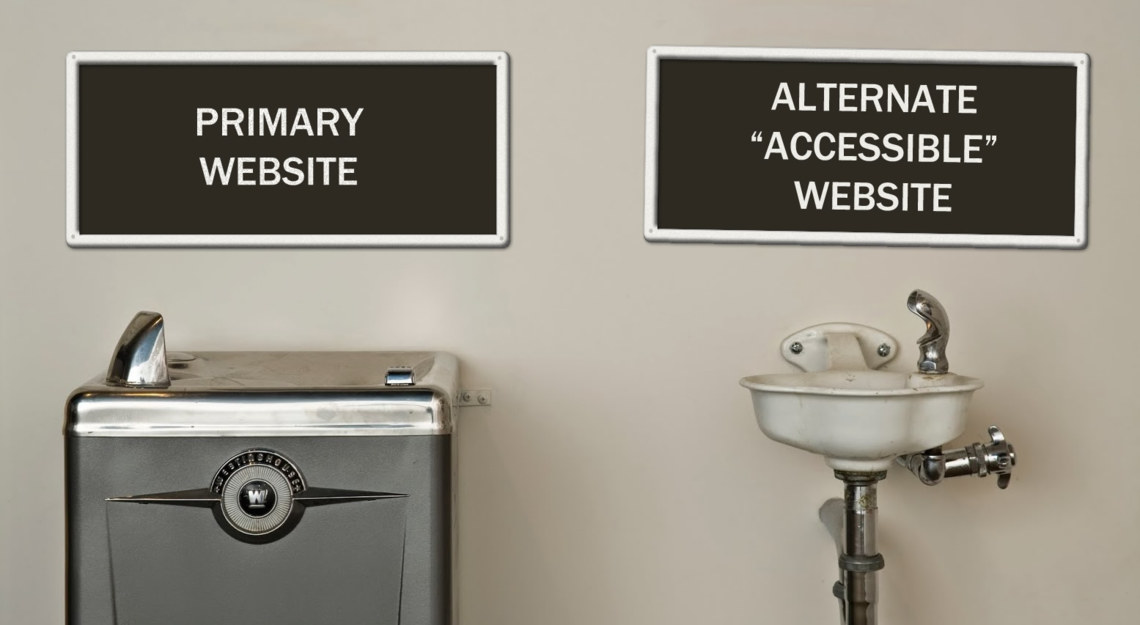
Separate But Not Equal : Why separate alternate “accessible websites” are bad.
Many businesses reacting to the surge in website accessibility lawsuits are desperately looking for low-cost ADA compliance solutions to avoid litigation. Naturally there is a growing market of “solution” providers attempting to fill the demand for a quick and inexpensive fix. Are these actually cheap fixes, or are do they ultimately increasing costs and legal exposure? Worse, might they be discriminatory?
In this dark-hat area of website ADA compliance solutions, there are two categories.
1. The first are javascript layers that modifies an existing website. This takes the form of an accessibility bar or button on that appears at the top or side of a webpage that alters aspects of the front-side to better conform to ADA.
2. The other is an option at the top of each page of a website that offers an “accessible version” of the website. This alternate website either strips out elements of the standard site that might fail to conform, or are completely different with only basic content.
Both fail to meet the needs of people with disabilities and are commonly rejected by the disability community. But there are aspects of the second “Accessible Version” option that are especially problematic and provide greater reason to avoid.
Why Alternate “Accessible” Website Versions Fail ADA And May Increase Legal Risk.
Here are three reasons why this approach fails to reduce legal exposure or provide adequate access for people with disabilities.
1. DOJ: All public accommodation’s websites must comply.
In Sept 2018, the Department of Justice reaffirmed that “the ADA applies to public accommodation’s websites". Not just a site that a company designates. There is nothing in the ADA or from the DOJ to suggest that an "accessible alternative" is an acceptable alternative, or that any alternative would be acceptable for that matter.
2. ADA = "Full & Equal Enjoyment"
The ADA states that people with disabilities are entitled to “the full and equal enjoyment of the goods, services, facilities, privileges, advantages, or accommodations” that a public accommodation provides to its customers. A separate website to serve as an alternative fails to provide full and equal enjoyment if it provides anything other than just that: full and equal enjoyment. The very notion of an alternate version itself violates this, as such an alternate version is designed to specifically to meet WCAG guidelines by removing content and features, which only others without disabilities can enjoy..
3. Is a "Separate But Equal" approach discriminatory?
Here there are clear parallels that take us back to the discriminatory practices of segregation. In 1954 Brown v Board of Education established "separate but equal" segregated schools for people of color violated the 14th Amendment 65 years ago. In parallel, is discrimination based on disability vs race different?
An Alternate Accessible Website Does Not Decrease Legal Exposure. Possibly the Opposite.
There is no evidence that this practice provides any legal protection in the first place. The primary website is still exposed, and any false security provided by an alternate accessible website will tend to discourage, rather than encourage work to make the primary website ADA compliant.
Could The Alternative Accessible Website Approach Increase Legal Risk?
Consider this. You are disabled and when visiting a site you are steered to a separate website only to discover it fails to provide the same information and features as the website enjoyed by people without disabilities. How would you feel? What might you do? Compare the many businesses with websites that fail out of ignorance, to this one that is deliberately trying avoid meeting the law and further discriminating against you in the process. Would you be more or less inclined to take action?
In The End, Does This Approach Save Money?
The irony here is that this approach is suggested to be a cost saving measure. However, maintaining two separate websites requires the addititional up-front setup costs and then doubles maintenance costs. Of course, in practice the two sites are never equally maintained, which only widens the legal gap as the two sites become less and less equal - further adding to deeper legal exposure. Since the approach doesn't actually protect from legal action, the innevitable legal costs ultimately punctuate this final point, which had been the goal in the first place.
So. Don't do this.
Further reading:
- Sheri Byrne-Haber, CPACC Certifield Accessibility Professional: Accessibility - Separate but Equal is Never OK